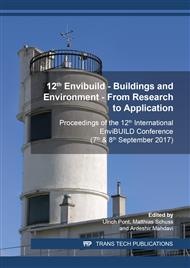p.80
p.90
p.98
p.109
p.117
p.129
p.140
p.148
p.156
Building Physics and Building Simulation: An Integrated Approach to Educational Programs
Abstract:
To fill the gap between the students’ knowledge of building physics, their comprehension of the different phenomena, and their capability of deploying building simulation with simulation tools, an integrated teaching approach for a course in a MS program in Energy Engineering has been adopted and tested for five years. In approximately 90 hours, the fundamentals of building physics are presented, starting from the thermodynamic balance of the indoor air volume, moving to the analysis of unsteady state thermal conduction in the envelope components, and to the convection and long wave radiation interactions at the external and internal surfaces, to conclude with the internal gains and the solar radiation. For each of the listed items, the students are first introduced to the topic with an exhaustive overview, then the main controlling equations are derived, their numerical or analytical solution analyzed, to conclude with a step-by-step implementation of a detailed solution, in a general productivity spreadsheet. At the end of the course, the spreadsheet has become a comprehensive simulation tool that, despite the limitations in computational efficiency, can favorably compare to the most diffuse tools available on the market, in terms of both detail and results, while allowing the students an insight into the physics and simulation of buildings thermal performance.
Info:
Periodical:
Pages:
117-128
Citation:
Online since:
January 2019
Authors:
Keywords:
Price:
Сopyright:
© 2019 Trans Tech Publications Ltd. All Rights Reserved
Share:
Citation:


